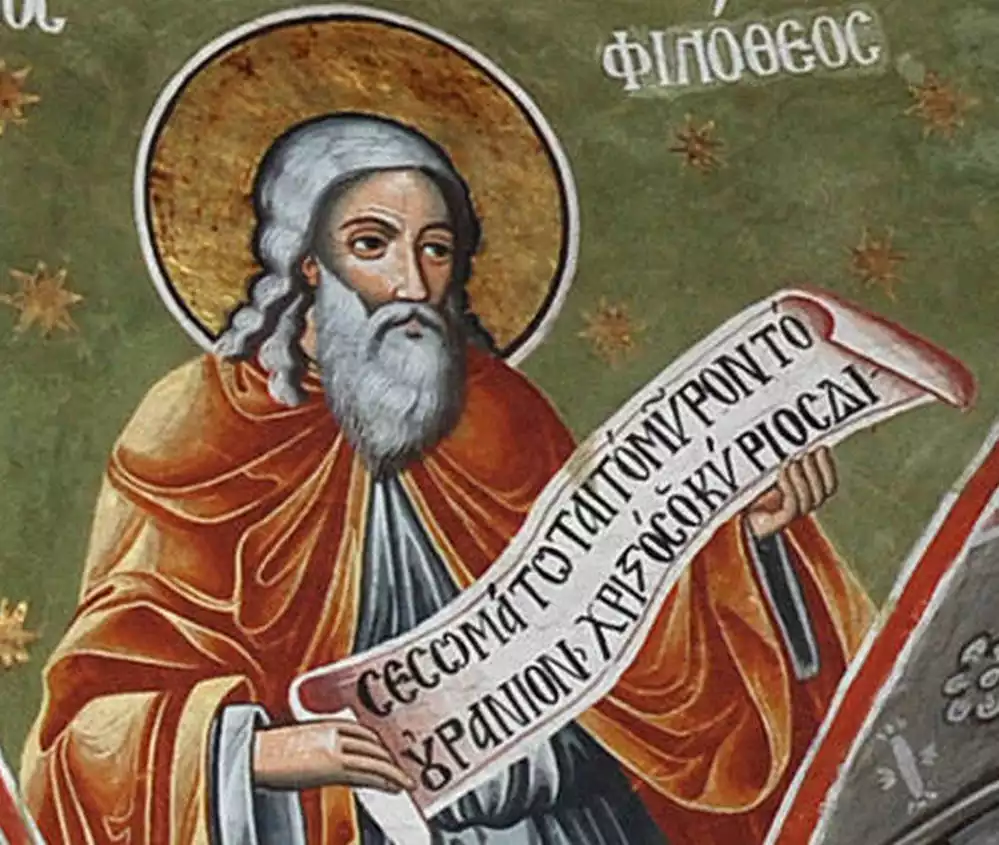
Saint Philotheos, born around 1300 in Thessaloniki and passing away in 1379, stands out as a pivotal figure in Orthodox Christian history. Renowned for his scholarly and clerical accomplishments, he was deeply involved in the Hesychastic controversies, a movement centered around the practice of inner stillness and prayer.
Early Life and Ascetic Endeavors
Saint Philotheos’ journey began in the historical city of Thessaloniki, born into a family of noteworthy heritage, with roots tracing back to Jewish ancestry. His early life was marked by an exceptional education, which included learning under the guidance of Thomas Magistros, a renowned scholar of the time. This foundation set the stage for Philotheos’ profound theological insights and his subsequent ascetic life.
Immersed in the tranquility of monastic living, Philotheos embraced the monastic way of life, first at the Monastery of Vatopedi and later at the Monastery of Megisti Lavra, located on the spiritually significant Mount Athos. His dedication and spiritual depth led him to assume the role of Hegumen (Abbot) of the Monastery of Philokalos between 1340/1-1342 and then of the Megisti Lavra from 1342 to 1345. During these formative years, Philotheos’ commitment to spiritual growth and contemplative life deepened, setting a strong foundation for his future theological contributions.
Involvement in Hesychast Controversy
As a fervent advocate for Hesychasm, Saint Philotheos played a crucial role in defending and promoting the teachings of Gregory Palamas, a key proponent of Hesychastic practice. His efforts were not only confined to monastic circles but extended to broader theological debates. Philotheos became known for his vehement opposition to Gregory Akindynos, a critic of Palamas’ teachings. He penned two significant theological discourses countering Akindynos’ arguments, thereby cementing his position as a staunch defender of the Hesychast doctrine.
His acumen in theological matters was further recognized when he was chosen as the Metropolitan of Heraclea in Thrace in 1347. This elevation marked a new phase in his career, bringing him into the heart of ecclesiastical power and influence. His tenure as Metropolitan coincided with a period of intense theological disputes, particularly around Hesychasm. In this role, he was instrumental in the drafting of the proceedings of the 1351 Council convened by Patriarch Callistus I, aimed at resolving the Hesychast controversy.
During this period, Philotheos’ contributions were vital in articulating and defending the Orthodox understanding of Hesychasm. His writings and actions helped shape the doctrinal positions that were eventually upheld by the Orthodox Church, particularly at the Council of Constantinople in 1351. This council played a pivotal role in affirming the teachings of Gregory Palamas and the legitimacy of the Hesychastic practices within Orthodox spirituality.
Saint Philotheos’ life and works thus highlight a critical era in Orthodox Christian history, marked by theological richness and spiritual depth. His contributions to the Hesychast movement not only enriched the spiritual lives of contemporaries but also left an indelible mark on the theological landscape of Orthodoxy.
Patriarchal Leadership and Ecclesiastical Diplomacy
Saint Philotheos’ ecclesiastical journey reached its zenith with his election as the Patriarch of Constantinople in 1353. This period was marked by significant political and religious challenges, yet Philotheos navigated these with remarkable acumen. His tenure as Patriarch, though interrupted, was a testament to his profound spiritual leadership and diplomatic skills.
In 1354, Philotheos crowned Matthew Kantakouzenos as Emperor, showcasing his influential role in Byzantine politics. His efforts to mediate between John V Palaiologos and John VI Kantakouzenos reflected his commitment to maintaining unity and stability within the empire. However, the ascent of John V to the throne in 1355 led to Philotheos’ dethronement. He subsequently resumed his role as Metropolitan of Heraclea until his re-election as Patriarch in 1364.
During his second patriarchal tenure, Philotheos strongly advocated for Hesychasm, firmly opposing the attempts by the Kydones brothers to introduce Thomistic scholastic theology into Byzantine thought. His steadfast defense of Orthodox theology was evident at the Council of Constantinople in 1368, where Prochoros Kydones was excommunicated, and the doctrinal authority of the 1351 Council’s Tome was reaffirmed.
Philotheos’ diplomatic skills were further highlighted in his interactions with the Papal throne, advocating for an Ecumenical Council to address the schism between the Eastern and Western Churches. Despite his firm Orthodox stance, he recognized the importance of dialogue and reconciliation. His efforts extended beyond Constantinople, significantly influencing the organization of Churches in Russia, Serbia, Wallachia, and Bulgaria, where Hesychasm gained considerable traction.
Saint Philotheos’ death in 1379 marked the end of an era of theological richness and ecclesiastical diplomacy. His life’s work significantly shaped the spiritual and doctrinal landscape of the Orthodox Church.
Saint Philotheos’ legacy as a theologian, monastic leader, and Patriarch is a testament to his profound spiritual insight and leadership. His unwavering dedication to Hesychasm and his contributions to the Orthodox Church’s theological discourse have left an enduring impact on Christian spirituality and theology.
Feast Day: October 11
References
- “The Philokalia: The Complete Text” – G.E.H. Palmer, Philip Sherrard, Kallistos Ware, Faber & Faber, 1983.
- “The Spiritual Heritage of the Eastern Christian Church” – Sophia Senyk, Theology Digest, 1993.
- Mihail Mitrea, “A Late Byzantine Hagiographer: Philotheos Kokkinos and His Vitae of Contemporary Saints”, PhD thesis, University of Edinburgh, 2018 (Accessed January 11, 2024).
- Philotheos Kokkinos, “Hypomnema on Saint Nikodemos the Younger (BHG 2307)”, Academia.edu (Accessed January 11, 2024).
